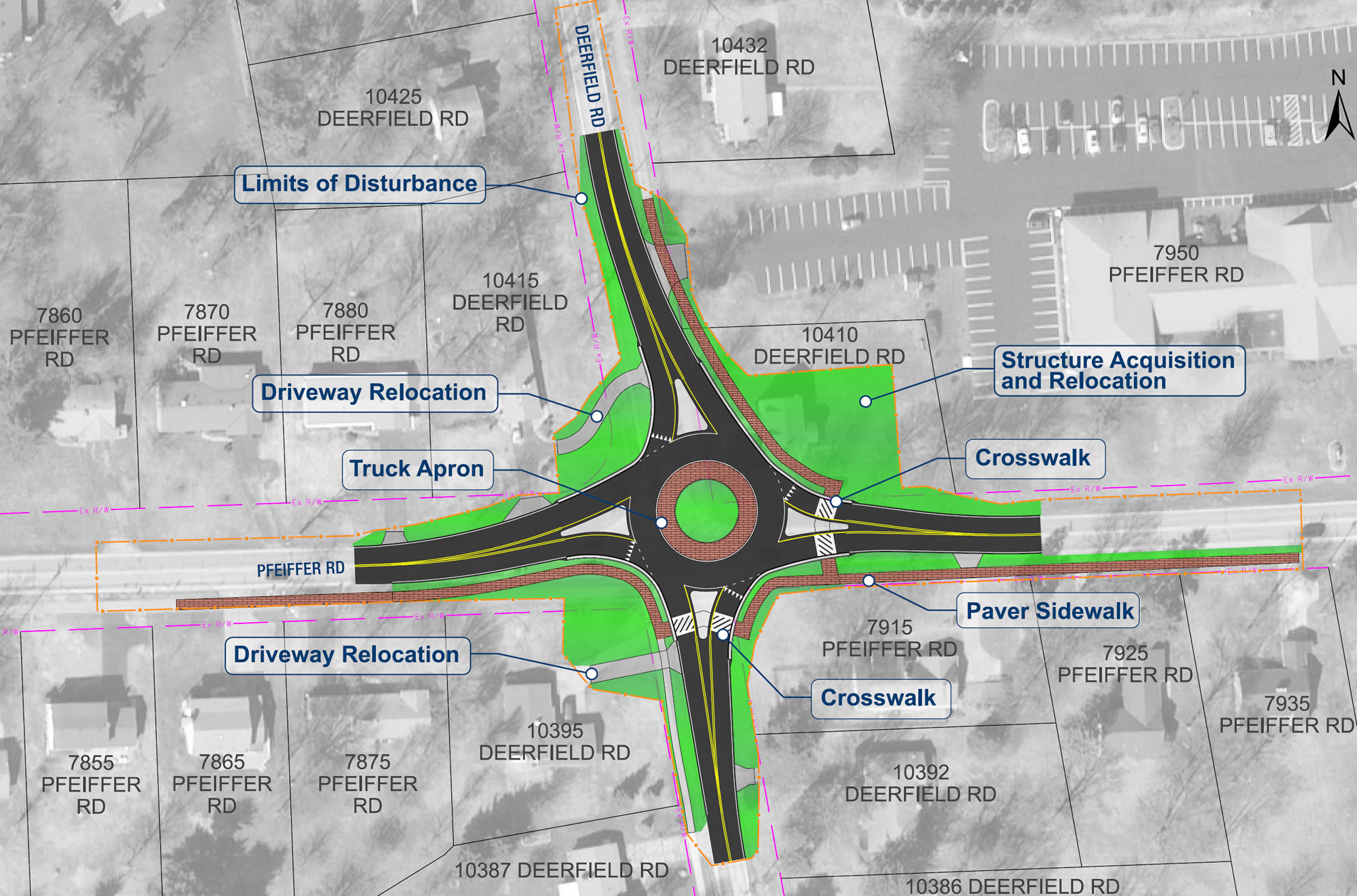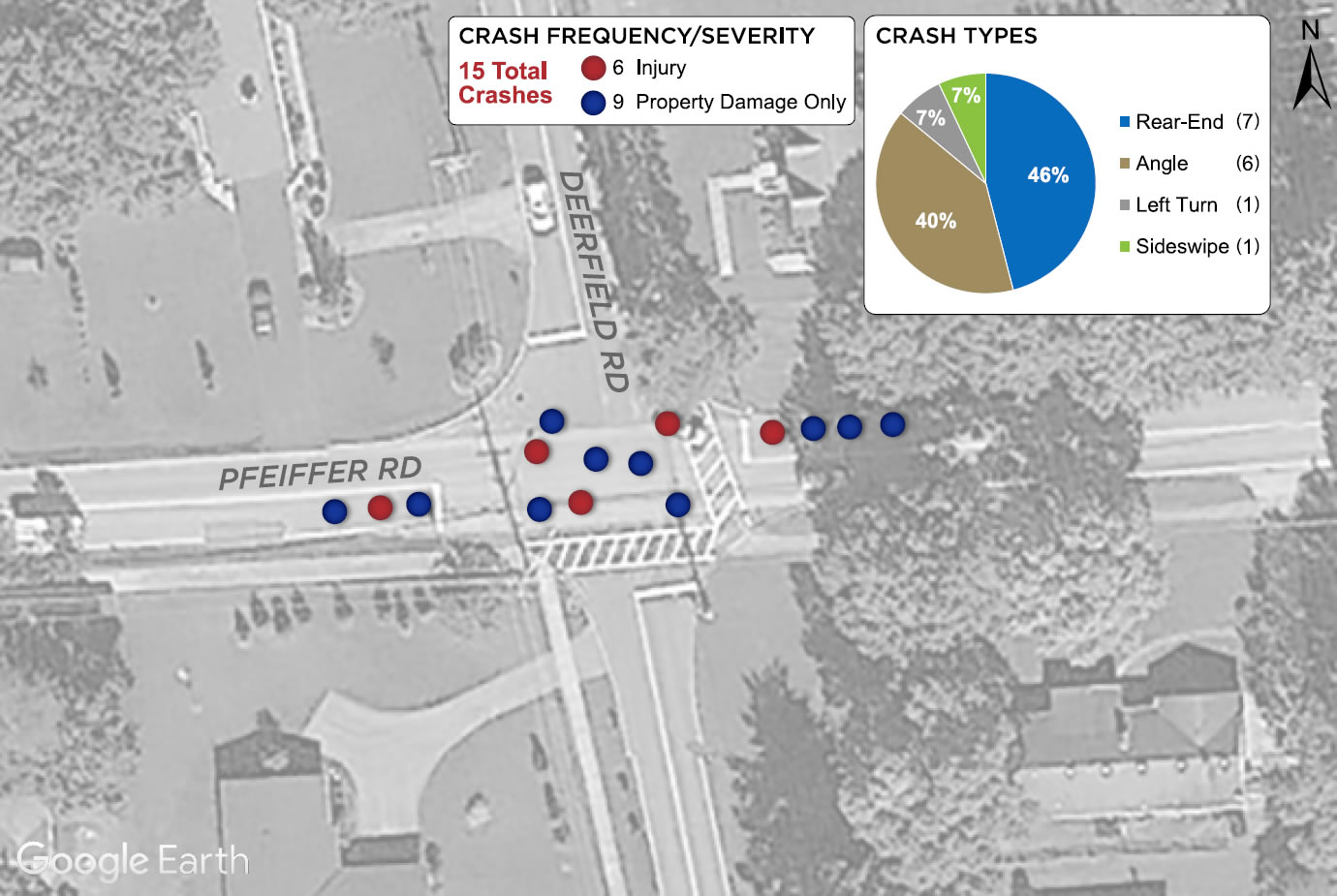Pfeiffer and Deerfield Roundabout Information
Purpose
The City of Montgomery is proposing to improve the intersection of Deerfield Road and Pfeiffer Road by converting the intersection to a modern, single-lane roundabout. Included with the project will be new curb, storm sewer, lighting, and pedestrian facilities.
The purpose of this project is to improve traffic flow, improve safety, and improve air quality at the intersection of Deerfield Road and Pfeiffer Road.
Questions?
If you have a questions, please contact the Public Works Director Gary Heitkamp by email or by phone at 513-792-8321.
Pfeiffer Rd and Deerfield Rd. Intersection Improvements

Safety
From 2016 to 2018, 15 crashes were reported at the intersection of Deerfield Road and Pfeiffer Road. Six ( 40 percent) of the crashes resulted in injuries and nine (60 percent) involved property damage only. The crash locations are indicated in the graphic below with red dots. The most common crash types were rear-end and angle crashes.
Crashes at the current Pfeiffer/Deerfield intersection

Safety Benefits
Roundabouts are one of the most effective intersection control treatments available with the added benefit of calming traffic. They limit vehicle speeds to approximately 20 mph and can control vehicle speeds on four approaches simultaneously.
Roundabouts achieve significant crash reductions because they simplify motorist decision making and have fewer conflict points. At a four-way intersection, there are 32 possible conflict points between vehicles and only eight at roundabouts.
Angle and left turn crashes account for 63% of fatal crashes at an intersection. These are typically more severe because of the speed and manner of impact. A roundabout eliminates angle and left turn crashes by forcing vehicles to make a right turn in and a right turn out. Crashes that do occur in a roundabout are sideswipe in nature and less severe due to low vehicle speeds.
Traffic Operations
According to traffic projections, the traffic flow through the intersection is currently performing at unsatisfactory levels during morning and evening rush hours. This condition is expected to continue if no improvements are undertaken. The table below describes the anticipated traffic delays and Level of Service (LOS). Current long-range traffic models predict no traffic growth in this area, so 2043 results are anticipated to match current results.
| Rush Hour | Existing Condition (All-Way Stop Control) | Proposed Condition (Single Lane Roundabout) |
|---|---|---|
| PM | F/83.2 sec delay | A/9.9 sec delay |
| AM | D/33.3 sec delay | A/8.1 sec delay |
LOS Key
- A = Free flow
- B = Stable flow with slight delay
- C = Stable flow with acceptable delay
- D = Approaching unstable flow
- E = Unstable low
- F = Congested with considerable delay
Funding
The City of Montgomery has been awarded Highway Safety Improvement Program grant funds covering 90 percent of engineering and right-of-way acquisition costs. The City has also been awarded construction grant funding through the Congestion Mitigation and Air Quality Improvement (CMAQ) Program covering 70 percent of construction costs.
Environmental Studies
An environmental overview will be prepared for the project to identify key environmental resources and constraints in the study area. Because federal funds are used, the project will need to follow Ohio Department of Transportation procedures in accordance with the National Environmental Policy Act (NEPA).
Pedestrian Crossing
How to drive a single-lane roundabout
The Rules of Roundabouts
When driving a roundabout:
- Slow down when approaching a roundabout.
- Observe signs and pavement markings.
- Choose your lane before entering the roundabout based on the direction you would like to travel (just like a traditional signalized intersection).
- Yield to traffic in ALL lanes to your left before entering.
- Stay in your lane until your exit. Do not change lanes in the roundabout. Do not stop in the roundabout.
Here are a couple of other things to keep in mind when driving in a multi-lane roundabout.
- You want to be in the right lane to turn right or go straight.
- You want to be in the left lane if you’re going to go straight, turn left, or do a U-turn.
To avoid a sideswipe collision, it is imperative that if you are in the right lane (outside lane) of the roundabout that you go right or straight (not left or around the roundabout) as you will conflict with the inside lane. You should choose the appropriate lane before entering the roundabout and proceed through the roundabout in the direction you have chosen.
It is important to remember large vehicles need more space in a roundabout. Avoid driving next to or passing large vehicles. Sometimes large trucks need both lanes to turn in the circle. They may even need to truck aprons to make a tight turn.
Questions?
If you have a question about the roundabout, please contact the Public Works Director Gary Heitkamp by email or by phone at 513-792-8321.
